It can be challenging to keep up with the ever-evolving list of dietary restrictions: vegan, vegetarian, gluten-free, paleo, dairy-free, and nut-free to name just a few. According to the International Food Information Council’s (IFIC) 2022 Food and Health Survey, 52% of Americans follow a specific diet or eating pattern, a 13% increase from 39% in 2021.
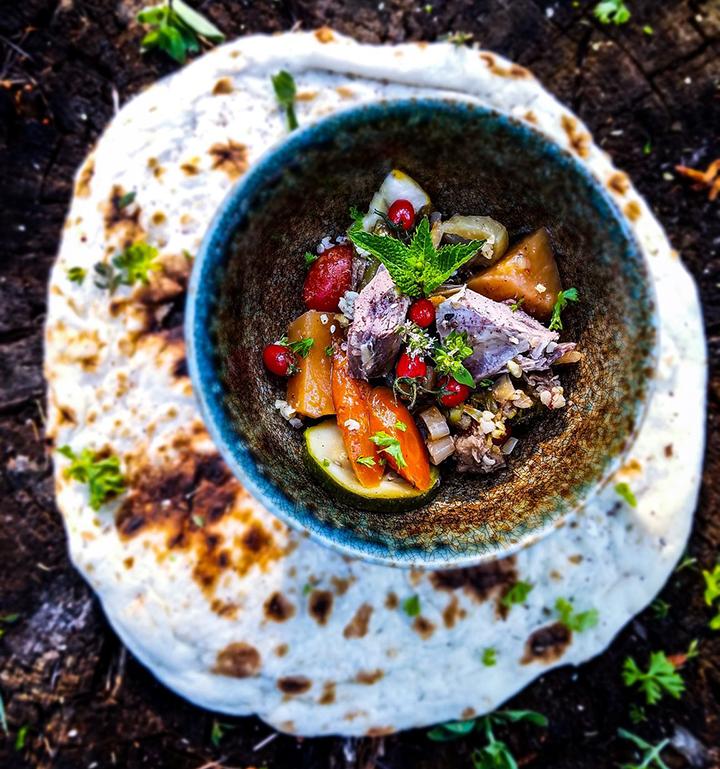
Lebanese-style lamb stew with from-scratch flatbreads. Photo courtesy Michael Fenster/Red Tail Productions
However, for many consumers (and chefs alike) there is one style of eating that is quickly becoming the default due to its health benefits and the fact that it can be customized to any diet: clean eating, which refers to eating foods as close as possible to their natural state. According to the IFIC survey, clean eating is one of the most popular eating patterns with 16% surveyed (followed by mindful eating at 14%, calorie counting at 13%, and plant-based at 12%).
“Clean eating for caterers is an opportunity to do what they do best—create delicious meals from scratch that surprise and delight, using local ingredients direct from the farm,” says Tracy Stuckrath (thrive! meetings & events). “It also allows them to more easily design menus around other dietary needs attendees may have by knowing what is in the menu item and how to adapt the recipe to meet needs.”
So, let’s take a look at clean eating: what it is, how to implement it into your menus, and how it can ultimately put you in a better standing with your clients.
What is clean eating?
As mentioned, clean eating is about eating fewer processed foods and more real, whole foods.
“Clean eating has become a spectrum, depending on each individual’s path,” says Sharon DeFelices (Mosaic Meetings and Events). “Clean eating includes healthy, whole foods with minimal processing. If you can pronounce the ingredients, that is a step in the right direction.”
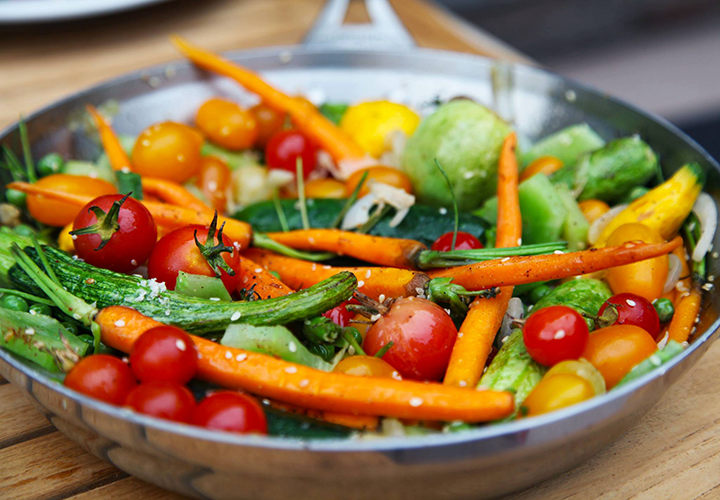
Montana farmers’ market vegetables. Photo courtesy Michael Fenster/Red Tail Productions
When looking at foods that are considered “ultra-processed,” the clean eating pattern is referring to foods that often have excessive amounts of undesirable sugars, salt, and fats added to their preparation “in order to maximize what is known as the ‘bliss point’ (the combination of sugar, salt, and fat that delivers maximum pleasure before a particular food is perceived as unpleasant),” according to American Culinary Federation chef and cardiologist Michael Fenster.
“Food has become a poor hungry ghost of its former glory,” Fenster said in a TEDx titled An Ordinary Meal. “It all starts with what we eat and what we need to eat is simply real foods, and ultra-processed foods are not real foods, they are either reassembled or fabricated—stitched back together like Frankenstein’s monster.
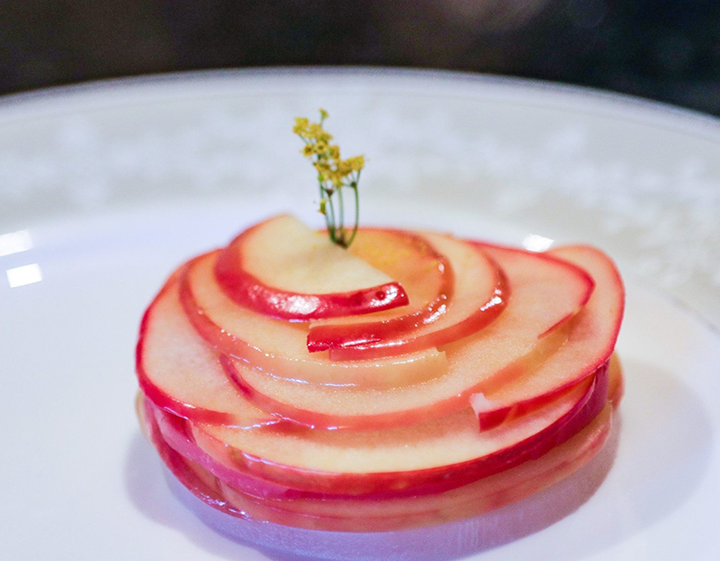
Gin-pickled apples and white beets. Photo courtesy Michael Fenster/ Red Tail Productions
“Obviously, food is needed for health and life, but there is no need to consume ultra-processed foods outside of convenience. What we need to do now is empower the individual to reconnect, reestablish, and reforge their relationship to their food experience.”
Not to be confused with a vegetarian diet, clean eating also allows for the inclusion of animal protein (such as grass-fed beef or organic chicken) as well as dairy products (such as all-natural milk and cheeses).
“Clean” foods can essentially be defined by the rule of five: if more than five ingredients are in the ingredient list, then about 85% of the time, it is ultra-processed.
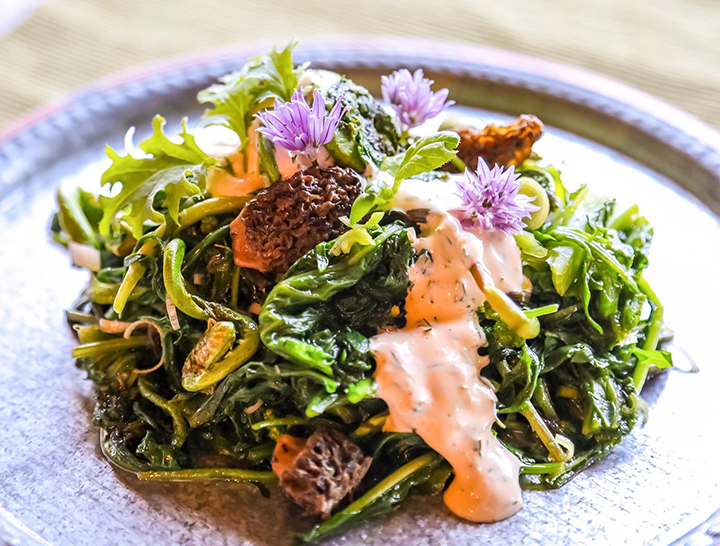
Warm Spring Salad with fresh morels and fiddlehead ferns. Photo courtesy Michael Fenster/ Red Tail Productions
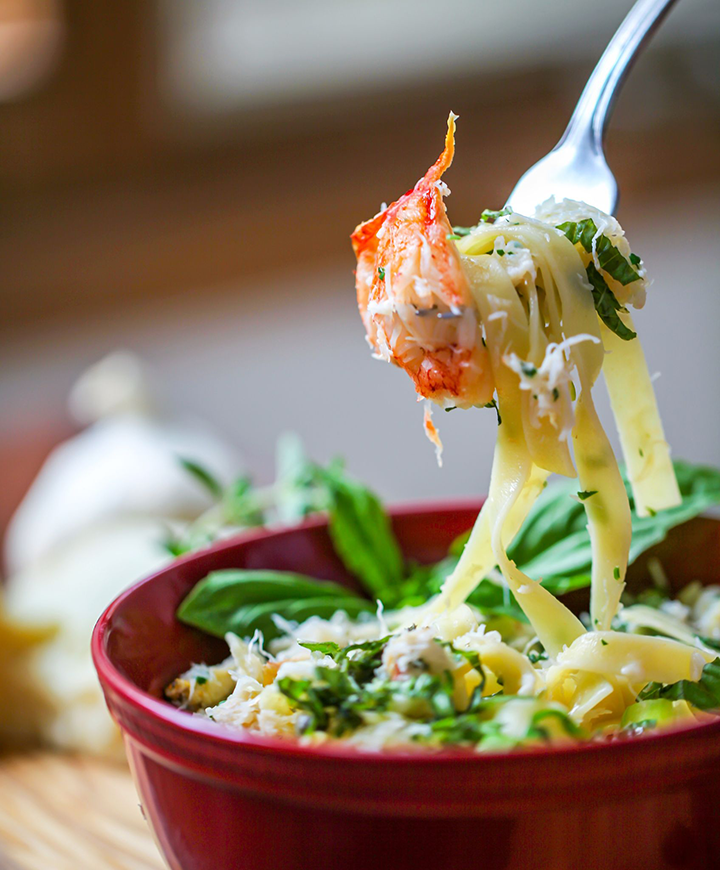
From-scratch pasta with herbs and lobster. Photo courtesy Michael Fenster/ Red Tail Productions
Fenster also encourages the avoidance of the six “danger zones”: salted meats, pre-prepared meals, favored yogurts/ white cheeses, energy and gourmet bars, breakfast cereals, and vegetarian (i.e., meat alternative) dishes. “We need to put the plants back in plant-based,” said Pam Smith during Veg- ”abilities”: Curating Plant-forward & Plantbased Menu Items That Are Craveable, Flexible & Forgivable (which she presented during Catersource + The Special Event this past March in Orlando, FL.)
Food with a purpose
One of the defining characteristics of clean eating (sometimes referred to as Culinary Medicine) is the health benefits associated with the foods that are considered “clean.”
“The health benefits of clean eating tie directly to the fact that foods in their natural state offer peak flavor and provide more nutrients that we need to improve our heart and brain health, strengthen our immune systems, and boost energy levels,” says Stuckrath. “Nutrient-dense foods provide vitamins and minerals, highquality protein, and healthy fats that highly processed, pre-packaged foods typically do not because they are rich in fat, sugar, sodium, preservatives, and more.”
According to the Mayo Clinic Health System, “clean” foods can help improve heart and brain health, assist with weight management, build a stronger immune system, and increase energy levels, among other benefits.
“As a cardiologist, I work to save lives. As a professional chef, I live to craft real delicious food,” Fenster said in his TEDx, “but right now, there’s very little food or life on our plates. We fundamentally changed the food that we have consumed since the dawning of humankind into something that people, and the bacteria in their gut that is so essential to health, have never ever eaten before. People are looking for food that promotes their health and well-being, not something that detracts from it.”
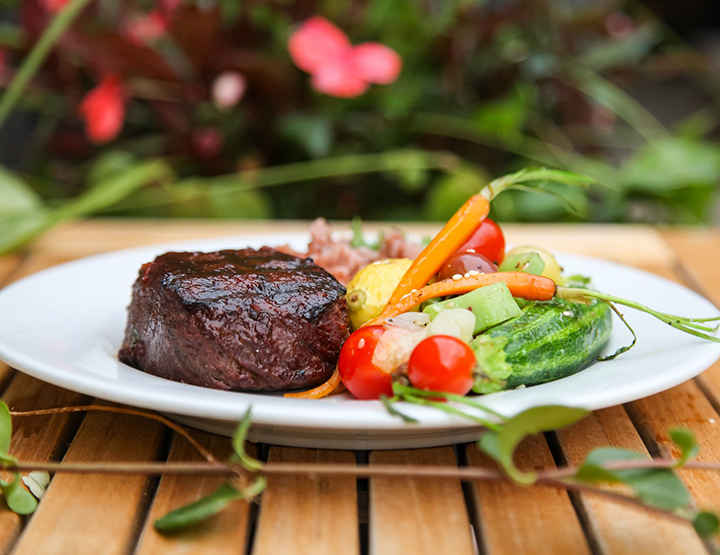
Montana wild antelope steak and farmers’ market vegetables. Photo courtesy Michael Fenster/Red Tail Productions
According to Unilever Foods’ Future Menu Trends report 2023, one of the biggest trends for 2023 is “Feel Good Food,” or “tasty dishes that boost the mind, body, and spirit.”
“We need to serve food that is not only delicious, but that has a little bit of an eye on wellness,” Smith said during her session. “The focus for so many years when it came to a dish that was prepared with an eye on health was really an eye on what to take out of the food: take out the salt, take out the sugar, take out the saturated fats, take out the calories; take out the flavor. What we need to do now is to put the focus on what to put in the food. ‘What can I get from food? What’s going to not only get me well, but keep me well?’”
Practical application
When thinking about clean eating from a practical perspective, caterers can easily leverage their existing relationships to help add clean options to their menus.

Potato leek soup (Potage Parmentier) with truffle goat cheese. Photo courtesy Michael Fenster/Red Tail Productions
“You don’t need to reinvent the wheel,” says DeFelices. “Take a look at seasonal, local produce and get to know your growers and their farm practices. You are probably already offering more clean options than you realize.”
- Purchase foods with fewer than nine ingredients (preferably fewer than five) that you can pronounce.
- Start growing some of the food yourself on your grounds, roof, or inside with a vertical farm.
“What is particularly powerful in our approach to clean eating is that it is not about deprivation; we are not eliminating whole classes of foods like carbs or gluten or focusing on a narrow nutrient-centric perspective like trying to make everything ow-fat or fat-free,” says Fenster. “There’s an incredible freedom of expression in being able to offer a wide range of foods that can accommodate an abundant and diverse assortment of flavor profiles.”
Menu considerations
When developing clean menus, below are some things to consider, according to Stuckrath:

Fresh poached asparagus with turmeric hollandaise. Photo courtesy Michael Fenster/Red Tail Productions
Nutritional balance
Menu options should be designed to provide a well-rounded nutritional pro le and meet customers’ dietary needs.
Ingredient quality
Emphasis should be placed on using highquality ingredients and avoiding artificial additives, preservatives, and other chemicals, to keep with the principles of “clean eating.”
Freshness and seasonality
Fresh ingredients should be prioritized, and menu options should be designed to use seasonal produce whenever possible.
Food preparation techniques
Steaming, grilling, roasting, or sautéing are often considered healthier options than deep frying or heavy use of oils or sauces, so use these when trying to enhance the nutritional benefits.
Portion sizes
Menu options should be appropriately portioned to provide a balanced meal that meets nutritional needs without excessive caloric intake.
Customization options
Scratch cooking eases customization of menu items to adapt by dietary needs and preferences.
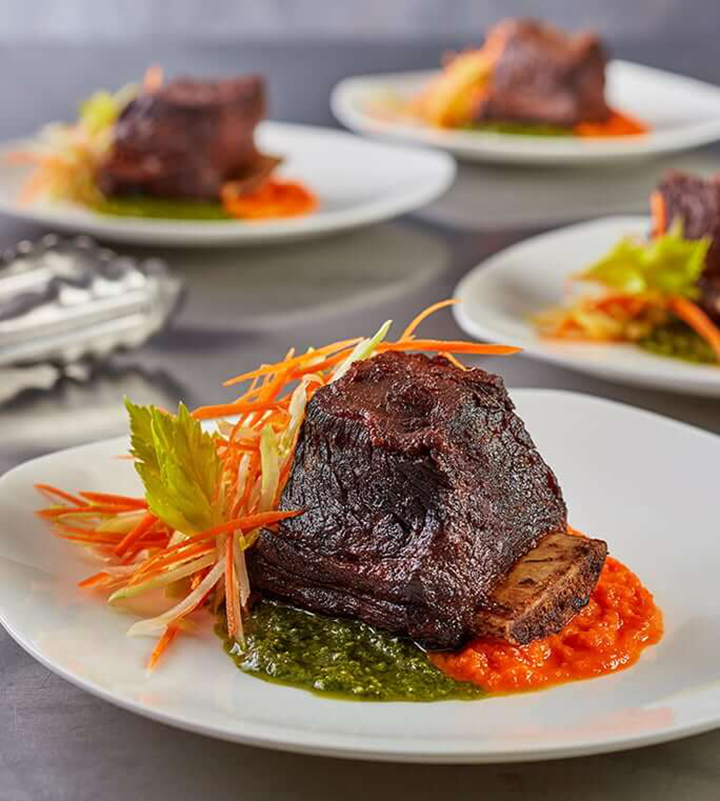
This “zero-waste” dish (Aussie Grassfed Beef Short Ribs) from caterer and chef Michele Lainez makes maximum use of every ingredient. The carrots in the braise become a puree for the plate, while the carrot tops are in the pesto. Celery leaves are incorporated into the celery slaw garnish. The braise itself gets reduced to a silky sauce, concentrating the umami flavor. Photo courtesy Aussie Beef & Lamb
Flavor and culinary creativity
While clean eating emphasizes the use of whole, unprocessed foods, it’s important to also prioritize flavor and culinary creativity to make the menu options delicious and enjoyable. Using herbs, spices, and other natural flavor enhancers can help create tasty and satisfying meals.
Sustainability and environmental impact
Partnering with your local farmers gives you a leg up on meeting the sustainability measures that many corporations are looking to achieve.
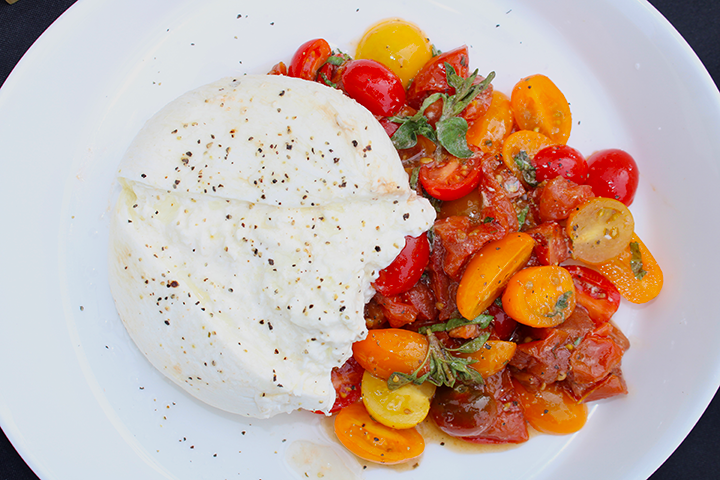
Heirloom tomato salad with burrata. Photo courtesy Culinary Canvas
Cost considerations
When developing clean eating menu options, using high-quality ingredients and following sustainable practices may impact the overall cost of the menu items, and pricing should be set accordingly to ensure profitability (check out the summer issue for ore cost-saving ideas).
“I think offering clean options for menus as an a la carte addition or menu swap is a gentler way to balance the cost increases,” DeFelices says. “Communication helps too! Explain your efforts for better ingredients and share where your foods come from. A price increase is a bit easier to swallow if it can be reasoned. Moving this needle is going to take time.”
When it comes to adding clean options to your menu, the sky’s the limit. “There is simply no limit to what you can offer; the caveat is in the sourcing and preparation,” says Fenster
Addressing consumer demand
The simple fact is that there is an increase in guests who want to eat clean, know where their food comes from, and get the nutrients they need, and this obviously provides a huge financial opportunity for caterers.
According to another IFIC survey, 64% of consumers surveyed said they try to choose foods made with clean ingredients, defined as “not artificial or synthetic,” “organic,” “fresh,” or “natural.” FMCG Gurus research indicates that 69% of U.S. consumers found clean label products appealing when described as “natural,” “synthetic-free,” “free from artificial ingredients,” and “containing real ingredients.”
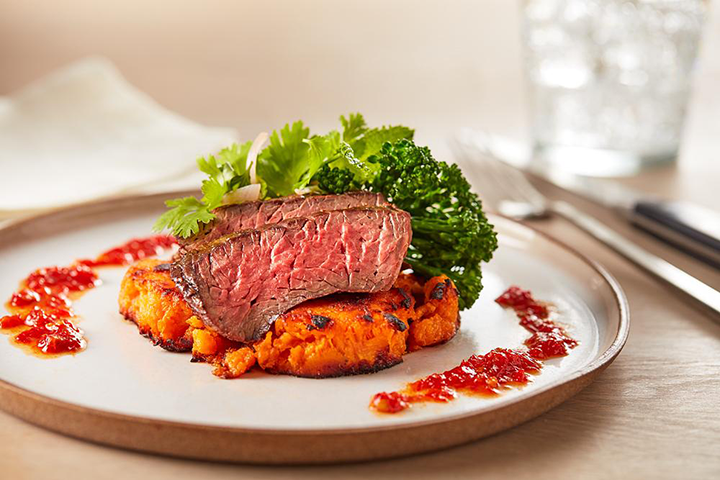
Harissa and Honey Glazed Aussie Beef Stuffed Sweet Potato (grassfed beef sirloin, sweet potato, and broccoli rabe). Photo courtesy Aussie Beef & Lamb
Additionally, if your competition is not doing it, this is a great opportunity for you to set yourself apart. According to Gluten and Allergy-free Passport, guests with dietary needs are 91% more likely to return to vendors after a positive dining experience; and Certistar research shows there is an opportunity to grow your revenue by 60% by offering options that meet multiple needs across the catering menu.
From the beverage side of things, data shows that 30% of people do not drink alcohol, according to Stuckrath. The nonalcoholic adult beverage market (which can be considered clean) is exploding and offers an opportunity to increase revenues by incorporating them into the menu—you can make more money on these than a can of soda.
The bottom line is clean eating offers your clients options.
“I think clean eating checks a lot of boxes for event attendees these days,” DeFelices says. “Clean eating gives you diversity of options. Weddings want decadence and corporate events want healthier foods, and as event guests trend younger and more culturally diverse, clean eating options are attractive on both menus. In the catering space, there are far more events that are looking for vegan and vegetarian options, as well as food allergies that we’ve never seen listed before. Why not celebrate that you are offering clean options on your inclusive menus.”



